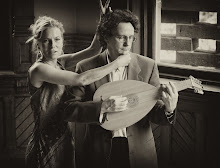New,
Very Elegant Songs and Dances
Nov. 15, 2014, 8PM
Heliconian Hall, Toronto
John Edwards - Lutes
Petite fantasie
dessus l'accord du Leut Adrian
Le Roy (c. 1520-1598)
Pavane est il
conclud/Gaillarde est
il conclud/Passameze
Fantasie Albert
de Rippe (c.1500-51)
Benedicta, a
Six/Secunda pars, Josquin
de Prez (d.1521)/Rippe
Per illud ave/Tertia
pars, Nunc mater
Les commandemens
de Dieu/Jubilate Genevan
Psalter, arr. Le Roy
Deo omnis/Nunc
dimittis/Ecce Nunc
Preambulo Secundo Giulio
Cesare Barbetta (1540-1603)
Ungay Bergier Thomas
Crecquillon/Barbetta
BonJour mon Ceur Orlando
Lassus/Sixt Kargel (d. c. 1594)
Madonna mia pieta Lasso/Kargel
Passamezo Zorzy/Il suo salterello Kargel
Intermission
Sanserre, Basse dance/Pavane
P.B./ Pierre
Blondeau? (fl. 1520s)
Gaillarde/Branle gay
La Magdalena,
Basse danse P.B./ Blondeau?
(Tourdion)/(Recoupe)
Prelude Blondeau?
Secoures moy Claudin
de Sermisy/Blondeau?
Tant que vivray Sermisy/Blondeau?
Jouissance Sermisy/Blondeau?
Pavane la
Milanoise/Gaillarde/ Guillaume
Morlaye (c. 1510-c. 1558)
Gaillarde piemontoise/Gaillarde
Fantasia Jean
Paul Paladin (fl. 1540-1560)
Anchor che col
partir Cipriano
di Rore/Paladin
Premier Branle de
bourgogne/Second Le
Roy
branle/Tiers
branle/Quatreyesme branle
Program Note
In the 18th century Johann Matheson joked ‘if a lute player
lives to be 80 he has surely spent 60 years tuning’. Adrian Le Roy, a lutenist
at the French court, makes this joke 175 years earlier with the Fantasie with which we begin. Beside his
court job Le Roy formed a publishing house with Ballard, printing chansons, and
from 1551, several books of lute and guitar music and a lute method surviving
only in a contemporary English translation. The decorated repeats of the Pavane and Gaillarde that Le Roy gives us are marked ‘plus diminuée’ or in the English version of the Passameze, ‘more
shorter’.
Albert de Rippe, born Alberto da Ripa, was another Royal lutenist, who
came from the lute-mad territory of the Marchesa of Mantua, Isabella d’Este. At
the end of the dense polyphony of the first part of his heavily decorated
version of Josquin’s six-voice motet he realizes the lute can’t compete with a
choir imitating the Archangel Gabriel saluting the Virgin Mary, so dazzles with
a flurry of notes rather than full throats. Josquin thins out to two voices for
the second part and brings all the voices back at the end of the third. After
this Le Roy’s busy versions of tunes from the Genevan Psalter, in use by French
Protestants and still in the hymnbook today, seem like pop music. Le Roy sticks
close to the chords of their first harmonizer Claude Goudimel, but puts the
Psalm tune in the top voice and avoids decorating it in the main, keeping the
‘more shorter’ notes in the other parts.
Pierre Attaingnant published a book of dances in 1521, the first
printed lute music in France. Many of the dances are by a ‘P.B.’, probably
Pierre Blondeau, a lutenist active at the time who may have been his editor.
The book contains some of the new Pavanes
and Gaillardes, but also many Basse Danses, an older dance form which
are audibly more ‘medieval’ sounding with their uneven phrase lengths and less
tonal melodies and harmonies. In 1529 Attaingnant printed a book of chansons
arranged for one voice and lute from 4 voice part originals and, overleaf from
each song, lute alone. The Branles
are formalized versions of rustic dances but not so domesticated as to have the
phrases ironed out into squares.
Morlaye was another publisher/lutenist and we can never be sure if he
is editor or composer of the music in his books. The fantasy by Paladin (the
Milanese Giovanni Paolo Paladino, publishing in Lyon) is unattributed in one of
Morlaye’s books.
Pity Nicholas Sarkozy. You can still see him on YouTube saying ‘it’s
nice to be here in Germany’ while visiting the French Region of Alsace, the
capital of which is Strasbourg, where Barbetta and Kargel’s books were printed
back when it was in Germany. Even the French President can’t keep straight what
country it’s in.










